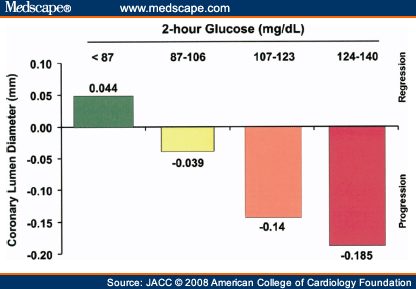In searching for information on some of the questions raised here I cam across an article from the American Journal of Cardiology (not the AHA!!) which I think summarizes a lot of great information and concepts. I am going to copy it in pieces because in that way at least I will read it.
Dietary Strategies for Improving Post-Prandial Glucose, Lipids, Inflammation, and Cardiovascular Health
Posted 01/29/2008
Posted 01/29/2008
James H. O´Keefe, MD; Neil M. Gheewala, MS; Joan O. O´Keefe, RD
Abstract and Introduction
Abstract
The highly processed, calorie-dense, nutrient-depleted diet favored in the current American culture frequently leads to exaggerated supraphysiological post-prandial spikes in blood glucose and lipids. This state, called post-prandial dysmetabolism, induces immediate oxidant stress, which increases in direct proportion to the increases in glucose and triglycerides after a meal. The transient increase in free radicals acutely triggers atherogenic changes including inflammation, endothelial dysfunction, hypercoagulability, and sympathetic hyperactivity. Post-prandial dysmetabolism is an independent predictor of future cardiovascular events even in nondiabetic individuals. Improvements in diet exert profound and immediate favorable changes in the post-prandial dysmetabolism. Specifically, a diet high in minimally processed, high-fiber, plant-based foods such as vegetables and fruits, whole grains, legumes, and nuts will markedly blunt the post-meal increase in glucose, triglycerides, and inflammation. Additionally, lean protein, vinegar, fish oil, tea, cinnamon, calorie restriction, weight loss, exercise, and low-dose to moderate-dose alcohol each positively impact post-prandial dysmetabolism. Experimental and epidemiological studies indicate that eating patterns, such as the traditional Mediterranean or Okinawan diets, that incorporate these types of foods and beverages reduce inflammation and cardiovascular risk. This anti-inflammatory diet should be considered for the primary and secondary prevention of coronary artery disease and diabetes.
Exaggerated post-prandial spikes in blood glucose and lipids induce proportional increases in oxidant stress, which acutely trigger inflammation and endothelial dysfunction and increased risk of future cardiovascular events even in nondiabetic individuals. Improvements in diet exert profound and immediate favorable changes in these post-prandial disturbances. Low glycemic index vegetables and fruits, nuts, lean protein, vinegar, tea, fish oil, calorie restriction, weight loss, and moderate- to low-dose alcohol each significantly improve post-meal inflammation. This anti-inflammatory diet should be considered for the primary and secondary prevention of coronary artery disease and diabetes.
Introduction
Systemic inflammation is increasingly recognized as an important mediator of coronary artery disease (CAD) and other common chronic degenerative diseases such as diabetes and Alzheimer dementia.[1] In many individuals a maladaptive diet is a major underlying cause of this chronic inflammation.[1,2] High-calorie meals rich in processed, easily digestible, quickly absorbable foods and drinks can lead to exaggerated post-prandial elevations in blood glucose and triglycerides.[3] Accumulating data from multiple lines of evidence suggests that this condition, termed post-prandial dysmetabolism, is an important and largely unrecognized fundamental disturbance involved in the genesis of inflammation and atherosclerosis.[3]
Exaggerated post-prandial spikes in glucose and lipids generate excess free radicals (or reactive oxygen species) that can trigger a biochemical cascade resulting in inflammation, endothelial dysfunction, and sympathetic hyperactivity.[4,5] These post-prandial changes when repeated multiple times daily eventually lead to atherosclerotic risk factors and CAD. Dietary and lifestyle factors play a central role in the etiology of post-prandial dysmetabolism.[3] The hypothesis of this review is that specific dietary strategies can dramatically and immediately improve post-prandial glucose and lipid levels, inflammation, and endothelial function, and if used in the long-term will also improve cardiovascular (CV) health.
Post-Prandial Hyperglycemia
Recent studies indicate that about one-third of American adults and two-thirds of CAD patients have abnormal glucose homeostasis.[6,7] A significant proportion of these at-risk individuals will have a fasting glucose level in the nondiabetic range (<126 mg/dl) but would show hyperglycemia diagnostic of impaired glucose tolerance (>140 mg/dl) or diabetes (>200 mg/dl) after an oral glucose tolerance test or a meal.
Continuous linear direct relationships exist between glucose levels after a glucose challenge and the risks of both CV death and all-cause mortality.[8] At only 80 mg/dl the CV risk of post-prandial or post-challenge glycemia begins to increase; by 140 mg/dl, the point at which we traditionally only begin to classify patients as glucose intolerant or pre-diabetic, the risk is already increased by 58%[9,10] (Fig. 1).
Figure 1.

Post-Challenge Glucose and Coronary Atherosclerosis Progression. Patients with normal glucose tolerance who had a post-prandial glucose level of <87 mg/dl had coronary regression. The remaining patients had coronary progression in proportion to the increase in post-prandial glucose. Data from Mellen et al. [10].
|





